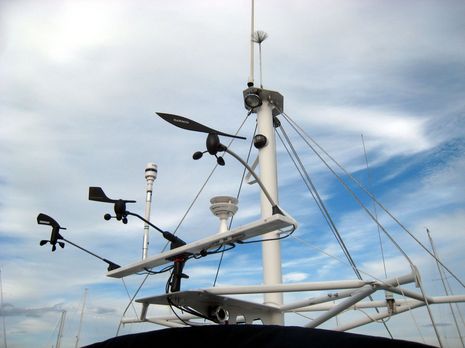Grand Valley State University’s wind turbine testing project for Muskegon Lake is shifting in a new direction
Instead of a wind turbine at the east end of Muskegon Lake, GVSU’s Michigan Alternative and Renewable Energy Center now is planning to move a wind test platform to Lake Michigan, where data can be collected on the pros and cons of turbines on a major lake.
The university has received $1.4 million in an “earmark” from U.S. Rep. Pete Hoekstra, R-Holland, to advance wind turbine generation on the Great Lakes.
The idea of testing a turbine on Muskegon Lake is cost prohibitive with the federal dollars available, according to Arn Boezaart, interim director of the Muskegon-based MAREC. Efforts to partner with L-3 Communications in Muskegon have not been successful.
Discussions with officials from the U.S. Department of Energy and those interested in advancing a Great Lakes wind industry in West Michigan led to the idea of a floating, data-collection platform in Lake Michigan.
The platform would hold a anemometer that gauges wind speed.
“This redesigned project can best contribute to the development of the wind industry in West Michigan and the state of Michigan,” Boezaart said. “I think it is pretty clear that the GVSU project will make a contribution to the future of the industry.”
A West Michigan planning group is working with GVSU to get the platform installed by fall 2010. The university must secure a match of at least $280,000 to obtain the federal dollars.
Studies of wind turbines on Lake Michigan in both Wisconsin and Michigan came to the same conclusion: There is no year-round wind data needed by prospective offshore wind development companies. National Oceanic and Atmospheric Administration buoys in Lake Michigan are pulled from the water during the winter months from November through March.
A data-collection platform established from 6-10 miles off the Muskegon shoreline would be left on the lake for two or three years. It would provide year-round wind data.
The floating platform also could test anchoring systems and show how Lake Michigan ice movements in the winter would affect an eventual lake-based turbine installation, Boezaart said.
Besides wind data collection, the GVSU Annis Water Resources Institute could use the platform to study Lake Michigan evaporation, while the U.S. Fish and Wildlife Administration would like to study bats on Lake Michigan. Bat kills are one of the issues the wind turbine industry must address.
Locating a wind turbine on Lake Michigan was a concept that federal officials thought was too ambitious. The test platform project advances design, permitting and construction issues that an offshore wind turbine developer would face. Permits likely would be needed from the U.S. Army Corps of Engineers, U.S. Coast Guard and the Michigan Department of Environment Quality, Boezaart said.
The GVSU advisory committee is looking at a platform that would by 10 by 20 feet, Boezaart said. It would need electricity from solar cells, a wind generator and back-up diesel engine to power the test equipment and provide navigational lights.
The GVSU planning group has brought together attorneys from Varnum law firm in Grand Rapids interested in permitting issues and Rockford Construction Co. and its Spanish partner Berge Logistica Energetica which plans to be in the turbine installation business. Also joining the group are economic developers from the West Michigan Strategic Alliance and the Right Place Inc. of Grand Rapids.
The group is working to find the 20 percent match needed for the $1.4 million in federal funds and is seeking state assistance.
The Michigan Public Service Commission, Michigan Economic Development Corp. and the state’s Department of Energy, Labor and Economic Growth have been asked to participate, Boezaart said. The GVSU effort also has drawn the interest of offshore wind turbine developers, he said.
By the end of January, GVSU will need to complete a final project design, identify the match money and provide letters of commitment, federal officials have said.
“The missing link that we hope to close is wind data for Lake Michigan,” Boezaart said. “Before any turbines go into Lake Michigan, we have to collect serious wind data.”
Share your industry press now!
Are you a PR agency or sustainability-focused organization? Join the World of Renewables network FREE today and gain exclusive access to our platform to promote your business, share the latest industry news, and connect with a global audience of 700,000+ renewable energy professionals.
Register Now to start posting your updates and showcase your expertise to a highly engaged, environmentally-conscious community.
Find out more about our Content Partnership Programs.*2024 AWARD WINNER* Websites & Mobile Sites, Webby Winner, Peoples Voice 2024
